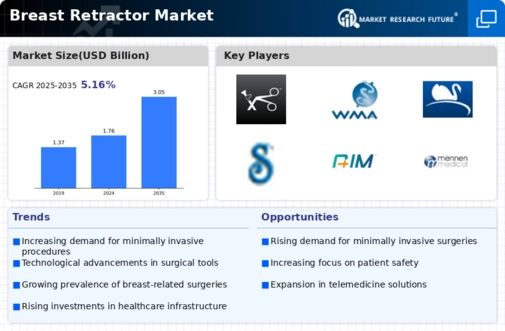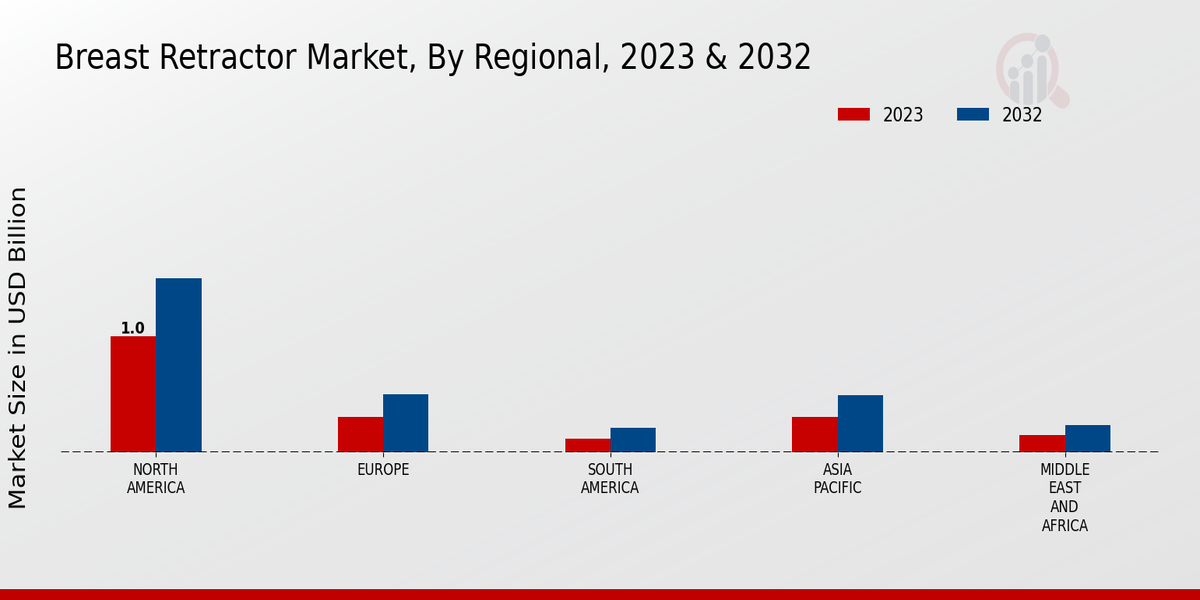Market Growth Projections
The Global Breast Retractor Market Industry is projected to experience substantial growth over the coming years. With a market value anticipated to reach 1.76 USD Billion in 2024 and further expand to 3.05 USD Billion by 2035, the industry is on a promising trajectory. The compound annual growth rate (CAGR) of 5.12% from 2025 to 2035 indicates a robust demand for breast retractors driven by various factors, including technological advancements, rising surgical procedures, and increased awareness of breast health. This growth reflects the evolving landscape of surgical instruments and the critical role they play in enhancing surgical outcomes.
Regulatory Support and Standards
Regulatory support and the establishment of standards for surgical instruments significantly influence the Global Breast Retractor Market Industry. Governments and health organizations are increasingly focusing on ensuring the safety and efficacy of surgical tools, which includes breast retractors. Compliance with stringent regulations not only enhances product quality but also boosts consumer confidence in surgical procedures. As manufacturers adapt to these regulations, the market is likely to benefit from improved product offerings and increased demand. This regulatory landscape fosters innovation and competitiveness within the industry, ultimately contributing to market growth.
Rising Incidence of Breast Cancer
The increasing prevalence of breast cancer globally significantly drives the Global Breast Retractor Market Industry. According to health statistics, breast cancer remains one of the most diagnosed cancers among women, leading to a higher demand for surgical interventions. As the number of surgical procedures rises, the need for effective surgical instruments, including breast retractors, becomes paramount. This trend is expected to contribute to the market's growth, with projections indicating that the market could reach 1.76 USD Billion in 2024. The emphasis on early detection and treatment further underscores the necessity for advanced surgical tools.
Increasing Awareness and Education
Growing awareness regarding breast health and surgical options among patients and healthcare professionals is a key driver of the Global Breast Retractor Market Industry. Educational campaigns and initiatives aimed at promoting breast cancer awareness have led to more women seeking preventive care and surgical solutions. This heightened awareness encourages healthcare providers to invest in high-quality surgical instruments, including breast retractors, to meet the rising demand. As a result, the market is likely to experience sustained growth, reflecting the importance of education in influencing patient choices and surgical practices.
Expansion of Healthcare Infrastructure
The expansion of healthcare infrastructure, particularly in developing regions, plays a crucial role in the Global Breast Retractor Market Industry. As countries invest in improving their healthcare systems, the availability of surgical facilities and trained personnel increases. This expansion facilitates more surgical procedures, thereby driving the demand for breast retractors. Moreover, government initiatives aimed at enhancing healthcare access contribute to the growth of the market. With the ongoing development of healthcare infrastructure, the market is poised for growth, reflecting the interconnectedness of healthcare advancements and surgical instrument demand.
Technological Advancements in Surgical Instruments
Technological innovations in surgical instruments are transforming the Global Breast Retractor Market Industry. The introduction of advanced materials and designs enhances the functionality and effectiveness of breast retractors. For instance, retractors with improved ergonomics and adjustable features allow for better visibility and access during surgery, which can lead to improved patient outcomes. The integration of minimally invasive techniques also necessitates the development of specialized retractors, thereby expanding the market. As these advancements continue, the market is projected to grow at a CAGR of 5.12% from 2025 to 2035, reaching an estimated 3.05 USD Billion by 2035.









